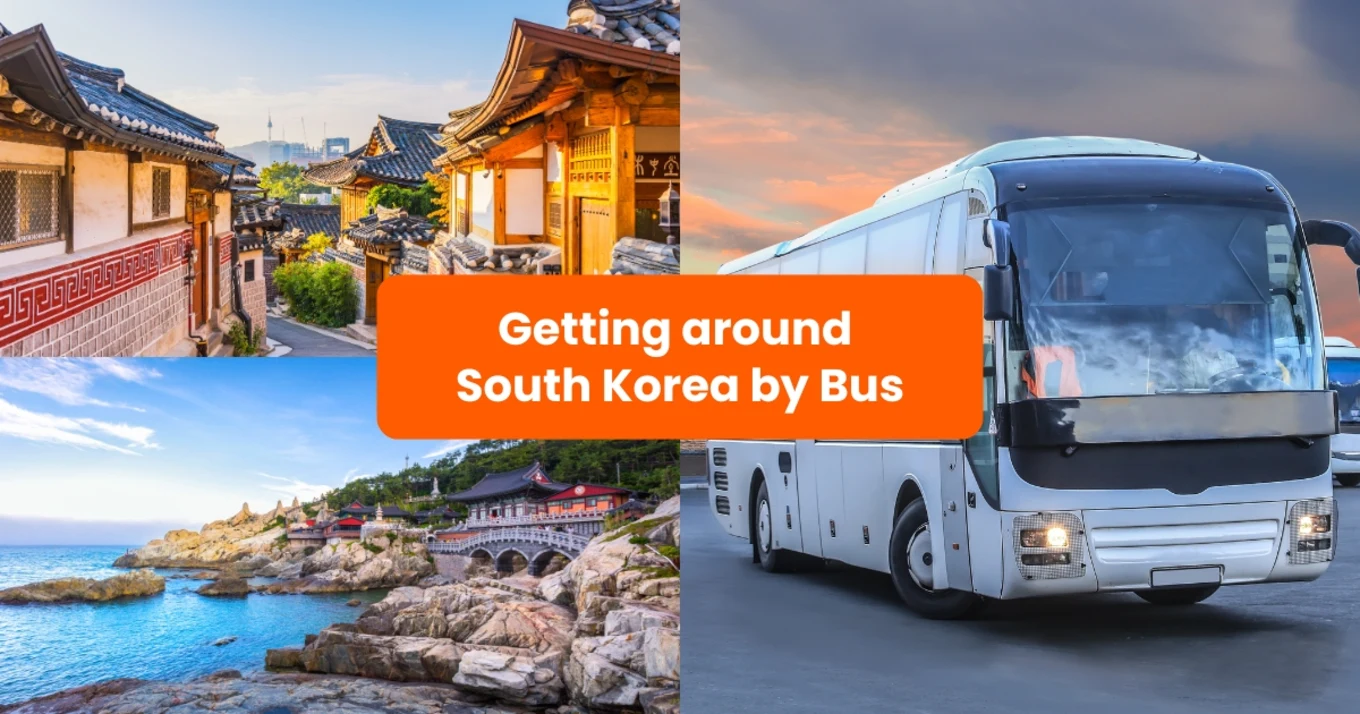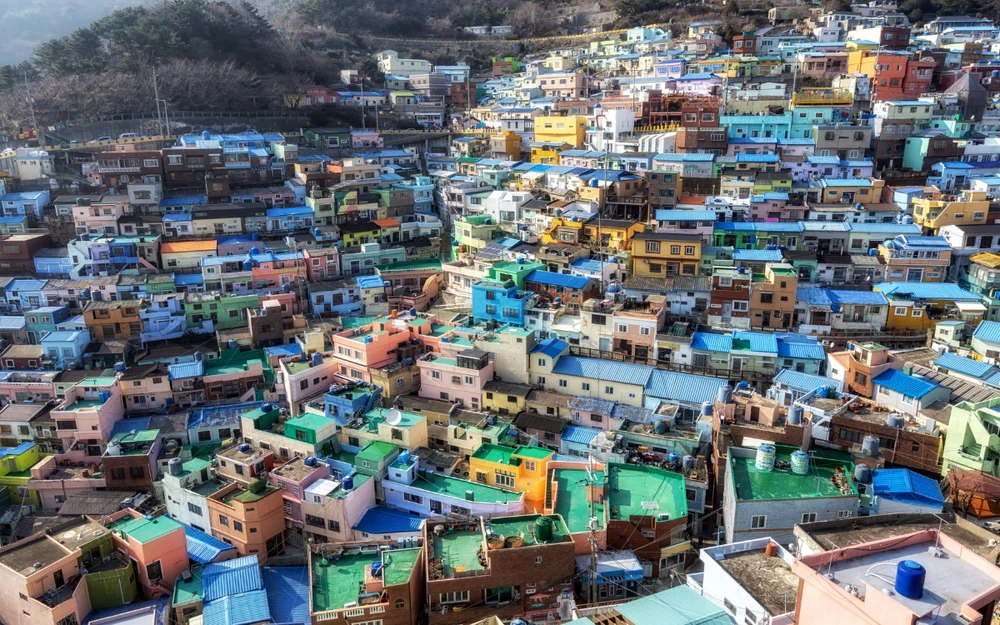An affordable and convenient way to get around South Korea
Need an affordable and easy way to travel across South Korea? The Korea intercity bus system is perfect for you. Intercity buses in South Korea are a cost-effective and comfortable travel option with an extensive network connecting major cities and hidden gems.
Popular routes include Seoul to Busan, Seoul to Sokcho, and Seoul to Jeonju, each offering unique scenic and cultural experiences. Tickets can be conveniently purchased online via platforms like Klook or on-site at bus terminals.
This guide explains why these buses are popular, the top routes, and how to book tickets in advance!
Why Choose Intercity Buses in South Korea
Imagine a mode of travel that not only saves your wallet but also unfolds a map of endless possibilities. In South Korea, intercity buses are just that — a golden ticket to explore the country’s diverse landscape.
With a blend of cost-effectiveness, an extensive network, and different levels of comfort, these buses are the go-to option for travelers looking to soak in every corner of Korea.
Affordable
Why spend a fortune on travel when you can explore South Korea without breaking the bank? Intercity buses are a testament to cost-effectiveness, offering a thrifty alternative to high-speed trains. With bus tickets starting from just ₩20,000, your journey across cities becomes as affordable as it is comfortable.
Extensive Network
Terminals in Seoul serve as hubs, offering routes that stretch to every nook of the country. From the Gyeongbu/Yeongdong Terminal’s access to the southeastern treasures to the DongSeoul Terminal’s gateway to the northeastern wonders, you’re never far from your next adventure.
Comfort and Convenience
Choose from three bus classes — Economy, Excellent, and Premium — each promising a journey tailored to your comfort needs. More details on what each bus seat class offers later in this guide!
Popular Routes for Korea Intercity Buses
Ready to explore some of South Korea’s most beloved destinations? Popular intercity bus routes weave through the country, offering convenient and scenic travel from Seoul to the coastal city of Busan, the mountainous escapes of Sokcho, and the cultural heartbeat of Jeonju.
Each route promises a unique tapestry of sights and experiences, with terminal addresses, travel times, and costs that cater to every traveler’s itinerary. Let’s journey through these popular routes!
1) Seoul to Busan
- Bus stations: Seoul Express Bus Terminal to Busan Bus Terminal
- Duration: 4 hours
- Seat options: Economy, Excellent, Premium (depending on bus timing)
- Cost: From ₩26,700
Busan, South Korea's second-largest city, offers stunning beaches, bustling markets, and cultural landmarks like the Gamcheon Culture Village and Haedong Yonggungsa Temple.
The Seoul to Busan intercity bus route is a popular choice for travelers, offering a scenic journey through South Korea's diverse landscapes. The route typically takes around 4 hours and provides a comfortable and cost-effective travel option.
This bus service is frequent, with around 2 to 3 departures every hour throughout the day, as early as 1AM and as late as 12AM.
Explore a different side of Busan by embarking on Klook's Savor Busan tour, where you get to enjoy local dishes recommended by locals and unique experiences such as hands-on traditional liquor making.
2) Seohandul to Sokcho
- Bus stations: Seoul Express Bus Terminal to Sokcho Express Bus Terminal
- Duration: 2.5 hours
- Seat options: Economy, Excellent, Premium (depending on bus timing)
- Cost: From ₩17,200
Sokcho, South Korea, is a picturesque coastal city known for its stunning beaches, vibrant seafood markets, and the nearby Seoraksan National Park that offers multiple trekking routes for you to hike!
You can easily get from Seoul to Sokcho in just 2.5 hours via the Korea intercity bus! The Express Bus Terminal in Seoul is your starting point, ending at Sokcho Express Bus Terminal. There are 2 to 3 bus services from Seoul to Sokcho every hour, with the first bus departing at 6AM and the last bus departing at 11:30PM.
3) Seoul to Gyeongju
- Bus stations: Seoul Express Bus Terminal to Gyeongju Bus Terminal
- Duration: 3.5 hours
- Seat options: Economy, Excellent, Premium (depending on bus timing)
- Cost: From ₩22,700
The Seoul to Gyeongju intercity bus route offers a journey through South Korea's rich historical tapestry. Taking approximately 3.5 hours, this route connects you to the ancient capital of the Silla Dynasty, where you can explore historic sites like the Daereungwon Tomb Complex, the Gyeongju National Museum or go on a soju brewery tour to learn about the history of Andong Soju that originated during the Silla period!
Buses depart every 1 to 2 hours, with the first bus from Seoul to Gyeongju leaving at around 6:50AM and the last bus leaving at 10PM.
4) Seoul to Seodaegu
- Bus stations: Seoul Express Bus Terminal to Seodaegu Express Bus Terminal
- Duration: 3 hours 10 minutes
- Seat options: Economy, Excellent, Premium (depending on bus timing)
- Cost: From ₩20,300
Seodaegu, often referred to simply as Daegu, is a vibrant city known for its rich cultural heritage and bustling markets. It's a perfect blend of tradition and modernity, offering travelers a unique glimpse into South Korea's diverse landscape.
Key attractions include the Daegu Yangnyeongsi Museum of Oriental Medicine and Seomun Market, each offering a distinctive experience of the city's charm.
Experience something different with an urban escape to Apsan Park or embark on a scenic hiking tour that takes you through the majestic Palgongsan mountain ranges in Daegu.
Buses depart twice every hour, with the earliest departure time from Seoul to Seodaegu at around 6AM and the latest bus leaving at 1:30AM.
Types of Bus Seat Classes
There are 3 bus types for South Korea intercity buses — Economy, Excellent, and Premium.
1) Economy
Economy seats offer basic comfort with standard legroom and seating arrangements, perfect for budget-conscious travelers. Seats are usually in a 2 by 2 layout.
2) Excellent
Excellent seats are in the mid-range category, providing enhanced comfort with more legroom and wider seats. There are 3 seats in a row, catering to those seeking a more relaxed journey.
3) Premium
Premium seats boast luxury features, including spacious reclining seats and privacy curtains — it's essentially like first class on a plane!
Journey across South Korea in comfort with additional amenities lke TV screens, a reading light, charging ports, and even free Wi-Fi!
How to Purchase South Korea Intercity Bus Tickets
Navigating the purchase of bus tickets in South Korea is a breeze. Whether it’s the convenience of an online platform like Klook, the official KOBUS website, or the traditional on-site terminals, securing your seat for the next journey is just a few clicks or steps away.
Let’s explore how you can snag those tickets!
1) Online via Klook
Klook is the only online travel agency that offers Korea intercity bus tickets for international tourists. It's a seamless process to book Korea intercity bus tickets on Klook — via the Klook website or Klook app (iOS and Android).
Booking your Korea intercity bus tickets online in advance means avoiding queuing at the bus stations and also securing the timing you want. Plus, booking your bus tickets on Klook allows you to make the purchase in your own language and preferred payment method — like PayPal, WeChat Pay, GrabPay, Google Pay, Apple Pay, and more.
After booking, you'll receive a QR code that serves as your ticket to board the bus, so there's no need to collect physical tickets!
Seoul Express Bus Terminal - Busan Bus Terminal (Round trip)
"The most cost-effective and convenient way to travel between Seoul and Busan. Booked two days before and immediately received the QR code needed to board the bus (no need to claim physical tickets). The designated outbound platform was indicated on Klook voucher so the bus was easy to find in the terminal. Maybe since I travelled on weekdays, the bus was not full when it departed from the terminal. Seat was premium as described, with a lot of leg room and fully functional buttons/usb charging port! Felt like I was in a business class of an airplane. Travel was right on time and quiet, with a stop halfway at a rest area for toilet and snack breaks. I definitely recommend this option when travelling in between cities!"
⭐⭐⭐⭐⭐ Review by Klook User (2024-03-28)
Seoul Express Bus Terminal - Sokcho Express Bus Terminal
"The bus was very comfortable and the ride was smooth. The scenery along the journey was pretty with many flowers blooming now and the bus went through countless tunnels before we travelled along the scenic coastal road at the last part of journey before reaching Sokcho Express Bus Station. We had a safe and enjoyable journey. Thank you Klook for providing this booking platform for intercity express bus rides from Seoul Express Bus Station."
⭐⭐⭐⭐⭐ Review by Klook User (2023-04-03)
2) Online via KOBUS
You can also book bus tickets on the KOBUS website which offers an English service to book your bus tickets online. However, the downside here is you will need a Korean number and credit card — which can be troublesome for visitors.
3) On-site at Bus Terminals
A third option is purchasing bus tickets at the terminal counters. South Korea’s bus terminals are equipped with manned booths and automatic ticketing machines, making on-the-spot purchases simple and efficient.
But of course, there's a chance that there might not be any seats left on the bus timing you want if you book tickets on the spot.
Tips for Taking Korea Intercity Buses
Before you hop on your next bus, a few insider tips can make your journey even smoother! From ensuring your gadgets stay charged to choosing the right attire for the road, these nuggets of wisdom are the cherry on top of your well-planned trip.
Let’s delve into some additional advice to keep in mind as you traverse the beautiful landscapes of South Korea.
1)K-Freeway Service Areas
Intercity bus rides in Korea are punctuated with stops at K-Freeway Service Areas, where cleanliness and convenience reign supreme. These rest stops are not just places to stretch your legs; they’re mini-oases with a variety of amenities, including:
- Food options
- Restrooms
- Convenience stores
- Souvenir shops
- Playgrounds
- Picnic areas
These service areas provide a comfortable and enjoyable experience for travelers. Some, like the Gapyeong Service Area, even offer unique amenities like a dog cafe, ensuring that every traveler (and their furry friends) can find respite on the road.
2) Book tickets in advance
Booking tickets in advance, especially during peak travel times, secures your seat and peace of mind. Keep an eye on updates and changes as your travel date approaches, and you’ll be well on your way to a hassle-free adventure.
3) Plan your time and itinerary accordingly
The bus journey may be longer due to traffic conditions — so don't book your activities or connections too close to the expected arrival time! During national holidays, travel time can be at least twice as long due to increased traffic and bus congestion. Add an extra hour's buffer to be safe.
Getting around South Korea
From the bustling cityscape of Seoul to the tranquil shores of Busan, South Korea’s intercity buses offer an unparalleled journey through the country’s rich tapestry.
Beyond the ease of travel, intercity buses are a gateway to the soul of South Korea, offering picturesque views and access to cultural and historical landmarks. From the serene Seoraksan National Park to the bustling Seomun Market in Daegu, each city reveals its own narrative.
Intercity buses are your chariot to these enriching experiences, immersing you in the diversity of Korean life.
Frequently Asked Questions
How much can I expect to pay for an intercity bus ticket in South Korea?
Intercity bus ticket prices in South Korea vary based on destination and class, ranging from ₩20,000 to ₩45,000, providing a cost-effective travel option.
Do I need to book my bus ticket in advance?
Yes, it's a good idea to book your bus ticket in advance, especially during peak travel times, to ensure you have a seat.
Can I purchase bus tickets if I don't speak Korean?
Yes, you can easily purchase bus tickets without speaking Korean through platforms like Klook or the KOBUS website, which offer multilingual interfaces.
What amenities can I expect on South Korean intercity buses?
You can expect comfortable seating, free Wi-Fi, and luggage storage on South Korean intercity buses. Premium classes may offer even more amenities and space.
Are there rest stops on long intercity bus rides in South Korea?
Yes, intercity buses in South Korea make regular stops at K-Freeway Service Areas where passengers can take a break and access various facilities.
How much luggage can I bring on an intercity bus in South Korea?
Most intercity buses in South Korea allow passengers to bring one or two pieces of luggage. Typically, there is an overhead compartment for smaller bags and a storage compartment under the bus for larger items. It's always a good idea to check the specific bus company's policy on luggage size and weight to avoid any surprises at the terminal.
Check out these Seoul travel essentials
🇰🇷 Seoul Travel Essentials 🇰🇷
Top things to do in Seoul
- Visiting multiple attractions in Seoul? Get the Klook Pass Seoul and enjoy up to 52% savings!
Getting around
- Airport transfer: AREX Incheon Airport Express | AREX Incheon Airport Express with T-money Card Car Transfer
- Train: KORAIL Pass
- Bus: Intercity Bus
Stay connected with our South Korea eSIM and find the best places to stay in Seoul — plus exclusive hotel promos and bundle deals!
More South Korea Inspiration
What is Klook?
Klook is Asia’s leading platform for experiences and travel services. We curate quality experiences ranging from attractions and tours to local transport and experiential stays, in over 2,700 destinations globally. Klook’s mission is to empower travelers around the world to discover, book, and experience the best things to do anywhere, anytime - including attractions, activities, car rental, tours, local transfers, wifi, and SIM cards.
✨ Follow us for more deals and inspiration for your upcoming travels




































